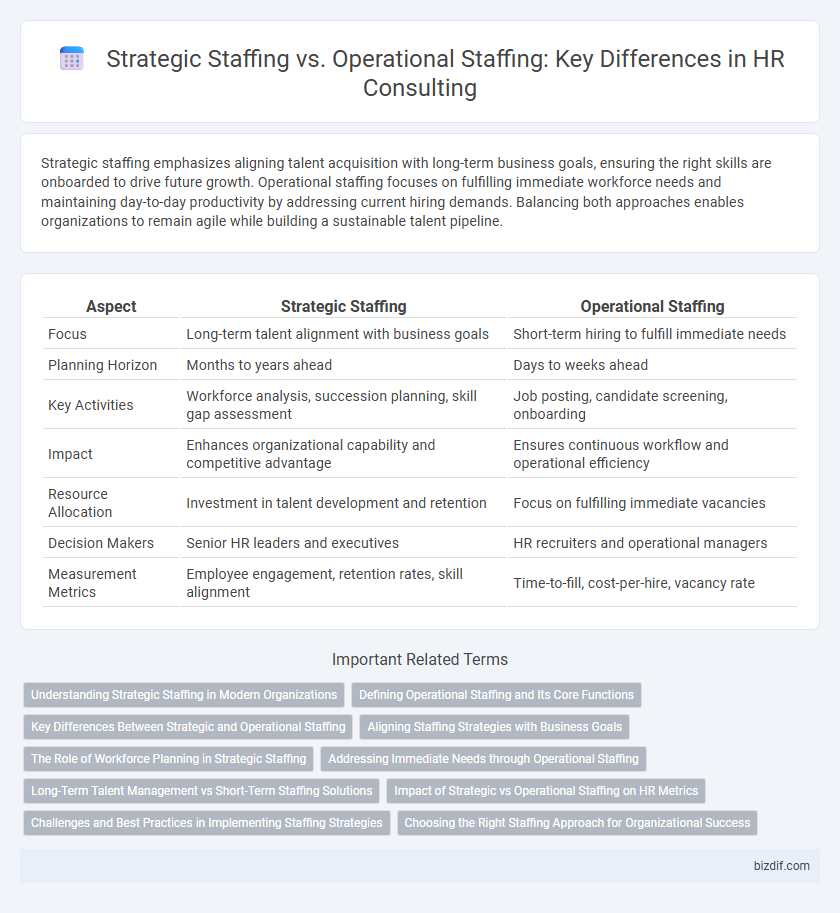Strategic staffing emphasizes aligning talent acquisition with long-term business goals, ensuring the right skills are onboarded to drive future growth. Operational staffing focuses on fulfilling immediate workforce needs and maintaining day-to-day productivity by addressing current hiring demands. Balancing both approaches enables organizations to remain agile while building a sustainable talent pipeline.
Table of Comparison
| Aspect | Strategic Staffing | Operational Staffing |
|---|---|---|
| Focus | Long-term talent alignment with business goals | Short-term hiring to fulfill immediate needs |
| Planning Horizon | Months to years ahead | Days to weeks ahead |
| Key Activities | Workforce analysis, succession planning, skill gap assessment | Job posting, candidate screening, onboarding |
| Impact | Enhances organizational capability and competitive advantage | Ensures continuous workflow and operational efficiency |
| Resource Allocation | Investment in talent development and retention | Focus on fulfilling immediate vacancies |
| Decision Makers | Senior HR leaders and executives | HR recruiters and operational managers |
| Measurement Metrics | Employee engagement, retention rates, skill alignment | Time-to-fill, cost-per-hire, vacancy rate |
Understanding Strategic Staffing in Modern Organizations
Strategic staffing in modern organizations involves aligning talent acquisition with long-term business goals to drive sustainable growth and innovation. This approach focuses on forecasting future workforce needs, developing talent pipelines, and enhancing employee value propositions to secure competitive advantage. Emphasizing strategic staffing enables companies to anticipate market changes and optimize human capital investments effectively.
Defining Operational Staffing and Its Core Functions
Operational staffing involves managing day-to-day workforce requirements to ensure business continuity and meet immediate operational goals. Core functions include employee scheduling, attendance tracking, and workforce allocation based on real-time project needs. This approach emphasizes maintaining optimal staffing levels to support ongoing activities and enhance productivity within established operational frameworks.
Key Differences Between Strategic and Operational Staffing
Strategic staffing focuses on long-term talent acquisition aligned with organizational goals, emphasizing workforce planning, talent forecasting, and competitive advantage. Operational staffing addresses immediate hiring needs, managing day-to-day recruitment processes, onboarding, and filling vacancies efficiently. Key differences lie in time horizon, with strategic staffing prioritizing future growth and operational staffing concentrating on current staffing demands.
Aligning Staffing Strategies with Business Goals
Strategic staffing involves forecasting future talent needs and aligning recruitment efforts with long-term business goals to drive organizational growth. Operational staffing focuses on filling immediate vacancies efficiently to maintain daily business functions without disruption. Aligning these staffing approaches ensures the workforce supports both current operations and future strategic objectives for sustained competitive advantage.
The Role of Workforce Planning in Strategic Staffing
Workforce planning plays a critical role in strategic staffing by analyzing long-term talent needs and aligning recruitment efforts with business goals to ensure sustainable growth. It involves forecasting future skill requirements, identifying talent gaps, and developing targeted strategies to attract, retain, and develop employees who will drive organizational success. This proactive approach contrasts with operational staffing, which focuses primarily on filling immediate vacancies and managing day-to-day workforce needs.
Addressing Immediate Needs through Operational Staffing
Operational staffing focuses on addressing immediate organizational needs by quickly filling temporary roles and managing day-to-day workforce fluctuations, ensuring business continuity and responsiveness. This approach prioritizes agility and efficiency in sourcing candidates for short-term projects, seasonal tasks, or urgent vacancies. Strategic staffing, in contrast, emphasizes long-term talent planning and alignment with business goals, but operational staffing remains crucial for sustaining productivity during unforeseen demands.
Long-Term Talent Management vs Short-Term Staffing Solutions
Strategic staffing emphasizes long-term talent management by aligning workforce planning with organizational goals, ensuring sustained growth and skill development. Operational staffing focuses on short-term staffing solutions, addressing immediate workforce needs through rapid recruitment and temporary placements. Effective HR consulting balances both approaches to optimize talent acquisition and retention while maintaining agility in fluctuating business environments.
Impact of Strategic vs Operational Staffing on HR Metrics
Strategic staffing significantly enhances key HR metrics by aligning talent acquisition with long-term business goals, leading to improved employee retention, higher productivity, and reduced turnover costs. In contrast, operational staffing primarily addresses immediate workforce needs, often resulting in faster hiring but less impact on employee engagement and long-term organizational performance. Data shows companies employing strategic staffing report up to 25% lower turnover rates and a 30% increase in internal promotions, demonstrating superior workforce stability and growth.
Challenges and Best Practices in Implementing Staffing Strategies
Effective implementation of strategic staffing often faces challenges such as aligning workforce planning with long-term business goals, managing talent pipelines, and balancing skill diversity. Operational staffing struggles include rapid response to immediate hiring needs, maintaining high employee retention, and optimizing resource allocation. Best practices involve leveraging data-driven analytics for predictive hiring, fostering cross-functional collaboration, and continuously evaluating staffing processes to enhance efficiency and scalability.
Choosing the Right Staffing Approach for Organizational Success
Strategic staffing aligns talent acquisition with long-term business goals by targeting high-potential candidates who drive innovation and growth. Operational staffing focuses on filling immediate, routine roles to maintain daily business functions efficiently. Selecting the appropriate staffing approach depends on organizational priorities, workforce demands, and the impact on productivity and competitive advantage.
Strategic Staffing vs Operational Staffing Infographic

 bizdif.com
bizdif.com